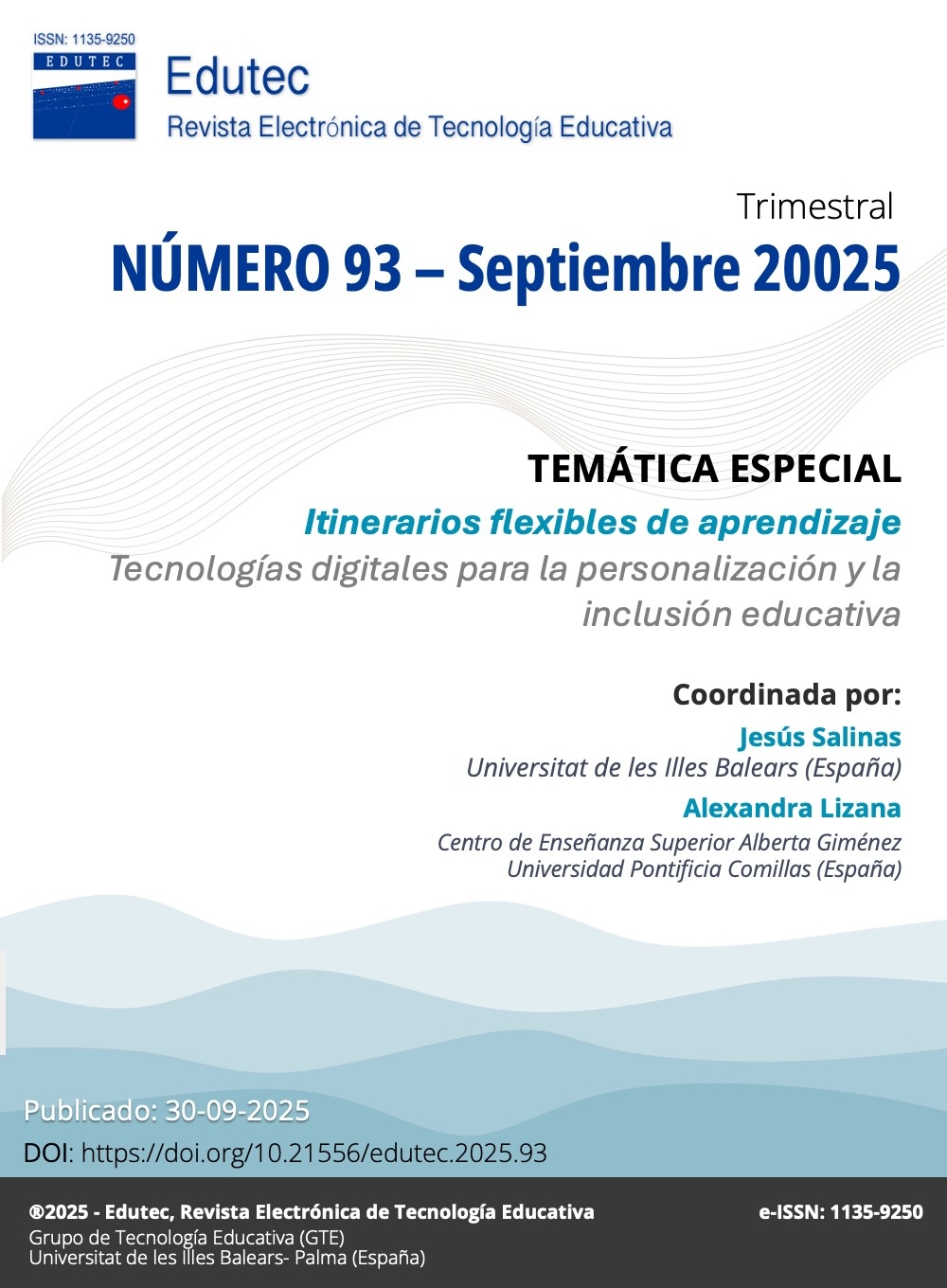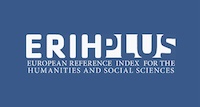AIDA-TIC: A methodological framework for integrating digital technologies into inclusive and flexible learning pathways in higher education
DOI:
https://doi.org/10.21556/edutec.2025.93.4063Keywords:
digital technologies, flexible learning pathways, educational inclusion, teaching digital competence, higher educationAbstract
This study analyses faculty adoption of digital technologies for designing flexible learning pathways in higher education, emphasizing personalized learning and educational inclusion. The hypothesis is that although faculty members perceive digital technologies positively, such perception does not translate into transformative pedagogical practices due to structural, training, and institutional constraints. Using a mixed-methods approach, a structured questionnaire was administered to 77 instructors at the Universidad Autónoma del Estado de Hidalgo. The instrument explored technological perceptions, digital competence, institutional conditions, and inclusive practices. Results indicate frequent use of conventional digital tools, but low integration of technologies for accessibility and personalized learning, along with significant gaps between perceived value and actual teaching competence. As a strategic response, the AIDA-TIC device (Alignment, Induction, Development, and Accompaniment) is proposed to coordinate institutional policy, situated training, and sustained pedagogical support. The study concludes that socially meaningful educational transformation requires integrated actions that empower faculty as central agents in building inclusive and flexible higher education models.
Downloads
References
Area Moreira, M., Bethencourt-Aguilar, A., & Martín-Gómez, S. (2023). HyFlex: Enseñar y aprender de modo híbrido y flexible en la educación superior. RIED-Revista Iberoamericana De Educación a Distancia, 26(1), 141–161. https://doi.org/10.5944/ried.26.1.34023 DOI: https://doi.org/10.5944/ried.26.1.34023
Bartolomé, A., Castañeda, L. & Adell, J. (2018) Personalisation in educational technology: the absence of underlying pedagogies. Int J Educ Technol High Educ 15, 14. https://doi.org/10.1186/s41239-018-0095-0 DOI: https://doi.org/10.1186/s41239-018-0095-0
Bray, B., & McClaskey, K. (2015). Make Learning Personal: The What, Who, Wow, Where, and Why. Thousand Oaks, CA: Corwin. Malaysian Management Journal, 19, 87–89. Retrieved from https://e-journal.uum.edu.my/index.php/mmj/article/view/9027
Brunner, J. J. (2014). La idea de la universidad pública en América Latina: narraciones en escenarios divergentes. Educación XX1, 17(2), 17–34. https://doi.org/10.5944/educxx1.17.2.11477 DOI: https://doi.org/10.5944/educxx1.17.2.11477
Conejo R, Guzmán E, Millán E, Trella M, Pérez-De-La-Cruz JL, Ríos A. (2004) SIETTE: A Web-Based Tool for Adaptive Testing. International Journal of Artificial Intelligence in Education 14(1):29-61. doi:10.3233/IRG-2004-14(1)03 DOI: https://doi.org/10.3233/IRG-2004-14(1)03
Creswell, J. W., & Plano Clark, V. L. (2018). Designing and conducting mixed methods research (3rd ed.). SAGE Publications.
Cueva Gaibor, Diego Abraham. (2020). Digital transformation in today's university. Conrado, 16(77), 483-489. Epub 02 de diciembre de 2020. Recuperado en 09 de abril de 2025, de http://scielo.sld.cu/scielo.php?script=sci_arttext&pid=S1990-86442020000600483&lng=es&tlng=en.
Davis, F. D. (1989). Perceived Usefulness, Perceived Ease of Use, and User Acceptance of Information Technology. MIS Quarterly, 13(3), 319–340. https://doi.org/10.2307/249008 DOI: https://doi.org/10.2307/249008
de-Benito, B., Moreno-García, J., & Villatoro Moral, S. . (2020). Entornos tecnológicos en el codiseño de itinerarios personalizados de aprendizaje en la enseñanza superior. Edutec, Revista Electrónica De Tecnología Educativa, (74), 73–93. https://doi.org/10.21556/edutec.2020.74.1843 DOI: https://doi.org/10.21556/edutec.2020.74.1843
Echeita Sarrionandia, G., & Ainscow, M. (2011). La educación inclusiva como derecho. Marco de referencia y pautas de acción para el desarrollo de una revolución pendiente. https://hdl.handle.net/20.500.12365/18038
García-Holgado, A., García-Peñalvo, F.J. (2018). Human Interaction in Learning Ecosystems Based on Open Source Solutions. In: Zaphiris, P., Ioannou, A. (eds) Learning and Collaboration Technologies. Design, Development and Technological Innovation. LCT 2018. Lecture Notes in Computer Science, vol 10924. Springer, Cham. https://doi.org/10.1007/978-3-319-91743-6_17 DOI: https://doi.org/10.1007/978-3-319-91743-6_17
García-Peñalvo, F. J., Fidalgo-Blanco, Á., & Sein-Echaluce, M. L. (2018). An adaptive hybrid MOOC model: Disrupting the MOOC concept in higher education. Telematics and Informatics, 35(4), 1018–1030. https://doi.org/10.1016/j.tele.2017.09.012 DOI: https://doi.org/10.1016/j.tele.2017.09.012
González Castaño, M. (2022). Investigación acerca del diseño universal para el aprendizaje en la formación profesional¿ Conocen y aplican los docentes de FP los principios y pautas del DUA como respuesta a la diversidad?. http://hdl.handle.net/10609/147006
Marín, V. I., Asensio-Pérez, J. I., Villagrá-Sobrino, S., Hernández-Leo, D., & García-Sastre, S. (2018). Supporting online collaborative design for teacher professional development. Technology, Pedagogy and Education, 27(5), 571–587. https://doi.org/10.1080/1475939X.2018.1547787 DOI: https://doi.org/10.1080/1475939X.2018.1547787
Mercader, C. (2019). Las resistencias del profesorado universitario a la utilización de las tecnologías digitales. Aula Abierta, 48(2), 167–174. https://doi.org/10.17811/rifie.48.2.2019.167-174 DOI: https://doi.org/10.17811/rifie.48.2.2019.167-174
Mercader, C., & Gairín, J. (2017). ¿Cómo utiliza el profesorado universitario las tecnologías digitales en sus aulas? REDU. Revista de Docencia Universitaria, 15(2), 257–273. https://doi.org/10.4995/redu.2017.7635 DOI: https://doi.org/10.4995/redu.2017.7635
Mishra, P., & Koehler, M. J. (2006). Technological Pedagogical Content Knowledge: A Framework for Teacher Knowledge. Teachers College Record, 108(6), 1017-1054. https://doi.org/10.1111/j.1467-9620.2006.00684.x DOI: https://doi.org/10.1177/016146810610800610
Monereo, C., & Badia, A. (2020). A dialogical self-approach to understanding teacher identity in times of educational innovations. Quaderns de Psicologia, 22(2), e1572-e1572. https://doi.org/10.5565/rev/qpsicologia.1572 DOI: https://doi.org/10.5565/rev/qpsicologia.1572
Pastor, C. A. (2018). El Diseño Universal para el Aprendizaje: Educación para todos y prácticas de enseñanza inclusivas. Ediciones Morata.
Redecker, C., & Punie, Y. (2017). European Commission: Joint Research Centre, European framework for the digital competence of educators : DigCompEdu, (Y..Punie,edito) Publications Office. https://data.europa.eu/doi/10.2760/159770
Robinson, D. E., & Wizer, D. R. (2016). Universal Design for Learning and the Quality Matters guidelines for the design and implementation of online learning events. International journal of Technology in Teaching and Learning, 12(1), 17-32.
Rose, D. H., & Meyer, A. (2002). Teaching every student in the digital age: Universal design for learning. Association for Supervision and Curriculum Development, 1703 N. Beauregard St., Alexandria, VA 22311-1714
Salinas, J. (2013). Enseñanza Flexible y Aprendizaje Abierto, Fundamentos clave de los PLEs. En L. Castañeda y J. Adell (Eds.), Entornos Personales de Aprendizaje: Claves para el ecosistema educativo en red (pp. 53-70). Alcoy: Marfil.
Scherer, R., Siddiq, F., & Tondeur, J. (2019). The technology acceptance model (TAM): A meta-analytic structural equation modeling approach to explaining teachers' adoption of digital technology in education. Computers & Education, 128, 13–35. https://doi.org/10.1016/j.compedu.2018.09.009 DOI: https://doi.org/10.1016/j.compedu.2018.09.009
Selwyn, N. (2019). What's the problem with learning analytics? Journal of Learning Analytics, 6(3), 11–19. https://doi.org/10.18608/jla.2019.63.3 DOI: https://doi.org/10.18608/jla.2019.63.3
Venkatesh, V., Morris, M. G., Davis, G. B., & Davis, F. D. (2003). User acceptance of information technology: Toward a unified view. MIS Quarterly, 27(3), 425–478. https://doi.org/10.2307/30036540 DOI: https://doi.org/10.2307/30036540
Published
How to Cite
Issue
Section
License
Copyright (c) 2025 Edutec, Revista Electrónica de Tecnología Educativa

This work is licensed under a Creative Commons Attribution 4.0 International License.
By submitting the paper, the authors assign the publication rights to the journal Edutec. For its part, Edutec authorises its distribution as long as its content is not altered and its origin is indicated. At the end of each article published in Edutec, the citation procedure is indicated.
The management and editorial board of Edutec Revista Electrónica de Tecnología Educativa do not accept any responsibility for the statements and ideas expressed by the authors in their work.
Translated with www.DeepL.com/Translator (free version)









